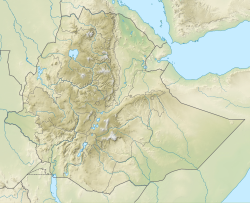|
Alaji Basalts
The Alaji (upper) Basalts are the youngest series of the Ethiopian flood basalts. The most recent flows are only 15 million years old.[1][2] Name and definitionThe name was coined by geologist William Thomas Blanford, who accompanied the British Expedition to Abyssinia in 1868,[3] after the Imba Alaje mountain. So far the nomenclature has not been proposed for recognition to the International Commission on Stratigraphy. Stratigraphic contextThe Alaji Basalts are the uppermost Tertiary flood basalts in Ethiopia. Locally they are covered by Pliocene shield volcanoes, such as the Simien Mountains, or Mount Guna. These flows have been deposited on the lower Ashangi Basalts and locally on intra-volcanic sedimentary rock. EnvironmentLike all volcanic rocks, the Alaji Basalts originate from initial melting of the Earth's mantle. After extrusion, the magmatic structures form at the surface. Common volcanic structures such as lava tubes or ropy lavas are absent in the Alaji Basalts, but (columnar joints) are omnipresent. The basalts comprise successive flows. During cooling, newly developed crystals within the lava solidify and develop congealing stress that favours the formation of columnar joints (intersecting fractures). They are perpendicular to the surface of the lava flow: mostly vertical, but sometimes also inclined or almost horizontal.[4][5] Lithology The Alaji Basalts hold alternating layers of rhyolitic and basaltic rocks. Its thickness varies between 80 and 220 metres. The upper layer is capped by trachytic materials. The lower part of the Alaji Basalts is composed of medium- to fine-grained basalts. The middle succession holds elongated plagioclase-dominated trachytes. The mineralogy of the basaltic rocks is marked by well-aligned elongated pyroxenes and micro-plagioclases. In the mineralogy of the trachytes one notices especially the by twinning of feldspar minerals and a small amount of altered pyroxenes.[4]  Geographical extentThe formation outcrops widely in the Ethiopian highlands, particularly in the upper landscape positions.[6] References
|
||||||||||||||||||||||||||||||||||||||
Portal di Ensiklopedia Dunia

